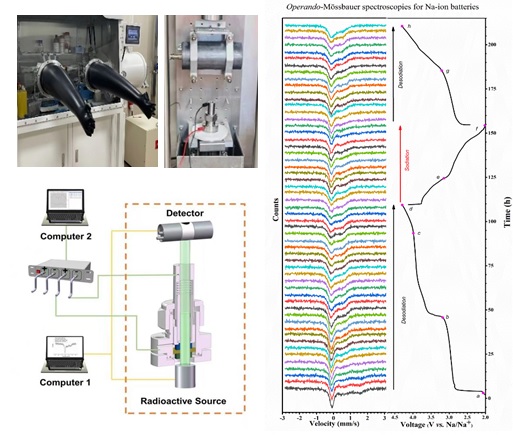Recently, a follow-up work, in-situ/operando ion battery Fe-57 and Sn-119 Mössbauer instrument has been developed by our Center in collaboration with Prof. Li Xianfeng & Asso. Prof. Zheng Qiong’s group from the Energy Storage Technology Research Department (DNL17), Dalian Institute of Chemical Physics and Dr. Moulay Tahar Sougrati from the University of Montpellier, France. The device can be used to dynamically observe the evolution of the Fe/Sn-based electrode materials in charging/discharging process, and reveal the intrinsic mechanism of the ion battery.
Mössbauer spectroscopy is the science of studying the behavior of electrons outside the nucleus. It has high energy resolution and can observe the hyperfine interactions of Mössbauer nuclides, and characterize the phase, valance, coordination structure and magnetism of the Mössbauer elements in samples, such as Fe and Sn. The in-situ/operando ion battery Mössbauer spectroscopy can be used to explore the changes of electronical, structural and magnetic properties of electrode materials under real working conditions. It is simple to operate and sensitive to detect. It is a powerful tool to study the structure-activity relationship and charge/discharge decay mechanism of electrode materials in novel high-efficient Li/Na/K iron battery development.
The operation method of in-situ/operando ion battery Mössbauer instrument is to first place the research electrode material, diaphragm, electrolyte, and counter electrode (Li/Na/K pieces, etc.) into designed in-situ/operando battery in a glove box; then Blue Electricity System, Mössbauer Spectrometer working together with the in-situ/operando battery, automatically record Mössbauer spectroscopy at certain intervals, so as to realize the stable measurement of the charge/discharge performance and the time-resolved Mössbauer spectrum at the same time. The in-situ/operando battery adopts a high-purity beryllium window with optimized thickness and diameter to ensure high transmittance of the Mössbauer signal, allowing sufficient pressure on the electrode and sufficient area for rapid data collection. The internal geometry of the in-situ/operando battery is suitable for vertical and horizontal Mössbauer measurement modes.
This work was funded by the Innovation Project of CAS Instrument and Equipment Function Development Technology, the Key Project of CAS International Partnership Program, and CAS President’s International Fellowship Initiative. (Text/picture by Ge Rile, Wang Zinan, Zhou Wenhui)
